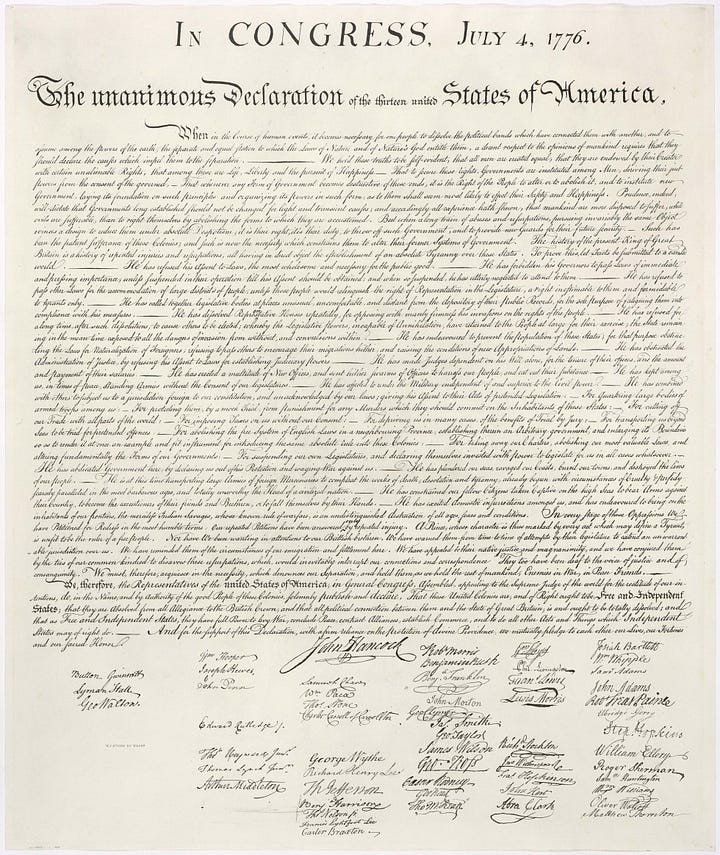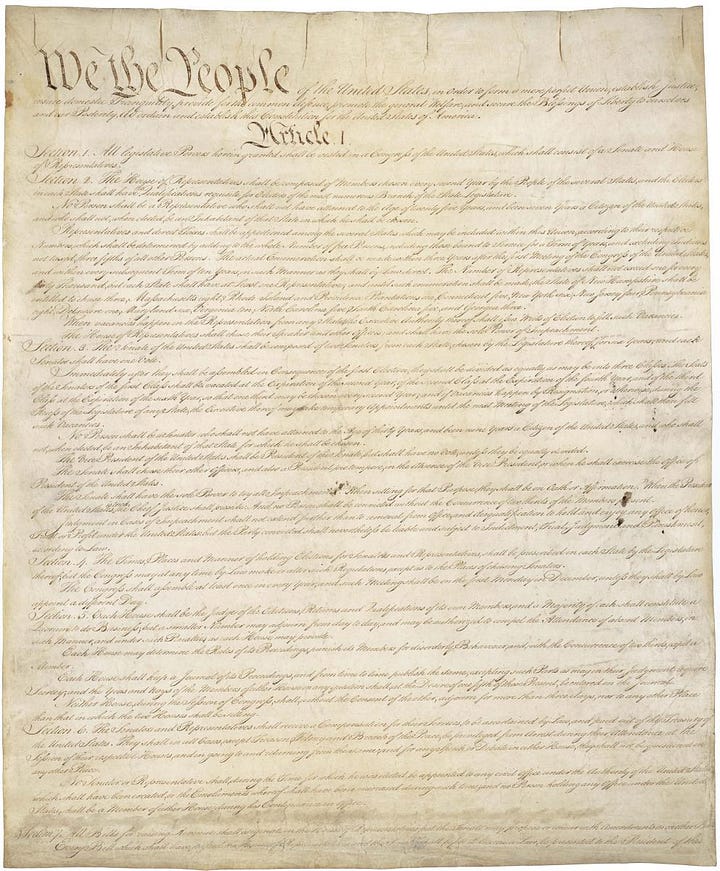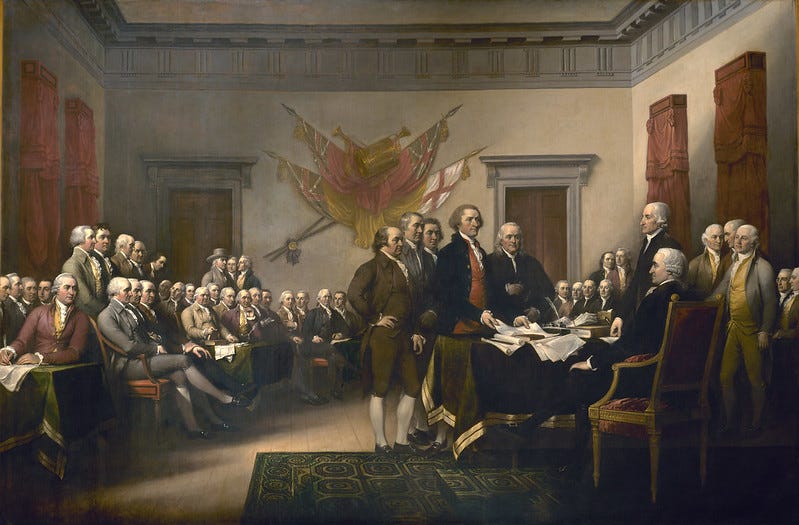America's Founding Documents are Extraordinary
A Very Brief Introduction to the Declaration of Independence and the U.S. Constitution


In this section of The Savvy Citizen, we’ll be breaking down the U.S. Constitution into its component parts, examining them in detail, and then reassembling them back into the unified whole.
Is it axiomatic that the two most important documents in American history are the Declaration of Independence and the United States Constitution. Everything else rests on them. Indeed the Constitution codifies the rights and liberties articulated in the Declaration.
Together, these two documents are the genesis, the bedrock, of our government and way of life aka a free society. Whether we protect the documents or trash them determines whether we continue to be free. It’s a high stakes game at this point.
Although we’ll be looking at the Declaration in detail in the “Founding of America” section, I would be remiss not to include it in this section’s inaugural post.
Reading the Founding
Both the Declaration and Constitution are relatively short and easy to read, especially if you have a basic understanding of how they’re organized and what they say.
We spend inordinate amounts of time searching for answers to our greatest challenges when we already have them - right at our fingertips.
I believe that Americans should read the Declaration of Independence and the Constitution at least once a year. They’re that important, and are still aspiring and inspiring.
Journalist Paul B. Skousen has written a great primer on these documents, and I’ve reproduced some of his highlights below. They were really useful for me, so I trust they will be for you too.
Remember 27
If you remember the Number 27, you’re well on your way.
The Declaration of Independence includes 27 charges against King George III.
The Constitution has been amended 27 times.
The Bill of Rights protects 27 rights.
The Declaration of Independence
The Declaration of Independence has five (5) sections:
Preamble
The Preamble identifies the purpose of the Declaration … When in the course of human events …
Assertions
The Assertion describes 8 ancient principles of freedom and unalienable Rights
The Charges
The Charges section lists 27 acts of tyranny and despotism committed by King George III
The Defense
The Defense lists the actions colonists took to resolve their differences with the King
The Declaration
The last part of the document us the actual Declaration of Independence from the King and his parliament.
It has 1,458 words, including 56 signatures, and takes about 10 minutes to read.
The United States Constitution
The U.S Constitution has a Preamble which is followed by seven (7) sections, called Articles.
Preamble
The preamble communicates the intentions of the framers and the purpose of the Constitution.
Article 1
Article 1 Establishes the Legislative Branch (Congress)
Article 2
Article 2 Establishes the Executive Branch (President)
Article 3
Article 3 Establishes the Judiciary (Courts)
Article 4
Article 4 Establishes Ground Rules for Interstate Relationships
Article 5
Article 5 Establishes the Amendment Process
Article 6
Article 6 Establishes the Supremacy of the Constitution over the States
Article 7
Article 7 Establishes Ratification Requirements
The Constitution has been amended 27 times, most recently in 1992.
The Constitution, including signatures and all 27 amendments, contains 7,591 words, and takes about 30 minutes to read. The Amendments take another 10 minutes or so to read.
America’s two most important founding documents, the Declaration of Independence and the United States Constitution, are clear and cogent masterpieces.
In just over 9,000 words - and not even an hour of reading - our entire system of government and a unique way of life was conceived, birthed, and amended to address the changing needs of a growing nation.
In fact, the U.S. Constitution was the first written constitution of its kind, enduring now for nearly 250 years. It has served as the model for written constitutions for nearly every nation in the world which has adopted one. Last I checked - that was every nation, except five.
As an Aside …
Lately, too many of my fellow citizens, have suggested that ideas first codified in government charters in the 18th century are no longer in vogue. In my opinion, it’s an immature and uninformed suggestion that cannot be tested against any empirical evidence, but I am always open to new and improved ideas if they’re presented in the form of an actual argument.
If you - or anyone you know - are among those who believe that 18th century ideas should no longer apply to modern America, I challenge you/them to:
explain why freedom is out of fashion
explain what you/they believe is superior, and
explain how you/their superior ideas should be implemented in America.
I am always open to dialogue and good faith discussion.
FWIW, I think many modern “dissenters” from democratic forms of government aren’t actually challenging the underlying principles of freedom, I think they’re frustrated with the relative application of them over time. This is an entirely different ball of wax and one I believe merits much consideration in current public and private discourse.
Meanwhile, stay tuned for content related to the U.S. Constitution in this section of The Savvy Citizen. We’ll be spending a bit of time discussing the founding prior to the Constitution in the Founding of America section for a bit, but will ensure that content related to the Constitution itself will be organized here.
Looking forward to your feedback …
Warmly,
Kelley
October 24, 2023







